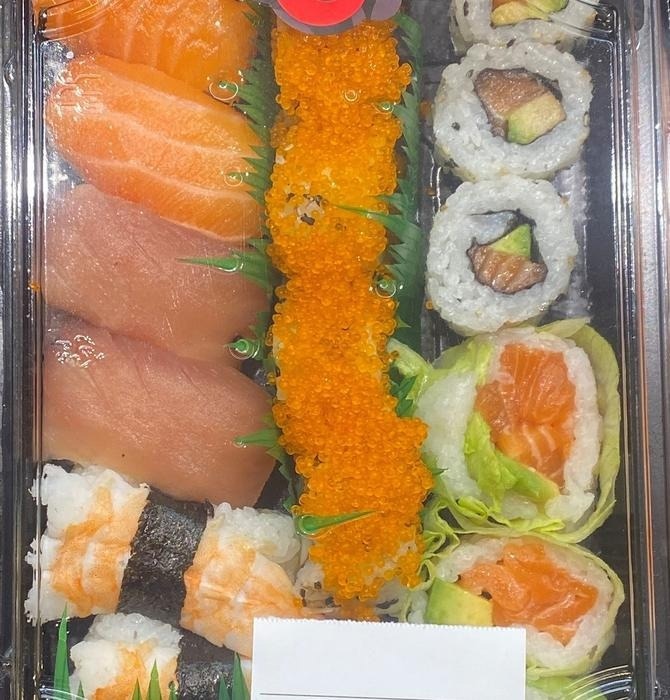Sushi is a popular meal choice in Norway and worldwide, with many people choosing sashimi and other raw fish when they want to indulge in good food.
 Sushi is generally safe to eat, but some bacteria in sushi, sashimi and cold-smoked fish products can pose a risk to people who eat such foods frequently, especially people with weak immune systems, children and the elderly. Credit: Idun Haugan, Norwegian University of Science and Technology
Sushi is generally safe to eat, but some bacteria in sushi, sashimi and cold-smoked fish products can pose a risk to people who eat such foods frequently, especially people with weak immune systems, children and the elderly. Credit: Idun Haugan, Norwegian University of Science and Technology
It is critical to emphasize that, in general, eating this type of food is entirely safe in Norway. However, while sushi can taste delicious, it also poses a health risk, both to individuals and to society as a whole.
Bacteria in sushi, sashimi and cold-smoked fish products can pose a risk to people who eat such foods frequently, especially people with weak immune systems, children and the elderly.”
Hyejeong Lee, PhD Research Fellow, Norwegian University of Science and Technology
Lee has recently finished her Ph.D. at Norwegian University of Science and Technology’s (NTNU) Department of Biotechnology and Food Science. In her thesis, she looked at different types of Aeromonas bacteria in seafood that have not been processed too much. The risk of bacteria levels being too high increases significantly if heat treatment or other antibacterial techniques are not used.
She added, “The goal was to gain more knowledge about Aeromonas in this type of seafood both the bacteria’s role in the deterioration of the product and in causing disease. Furthermore, we wanted to see if raw seafood can spread antibiotic-resistant bacteria.”
Listeria monocytogenes is the most well-known detrimental bacteria associated with raw or lightly cooked seafood. However, the presence of Aeromonas in these goods has long concerned experts.
Mild Processing Does Not Inhibit Bacterial Growth
Lee began with fish items that are widely available on the Norwegian market. She tested these items for Aeromonas bacteria.
Lee noted, “The results show that the mild processing these fish products receive does not guarantee that the growth of Aeromonas bacteria will be inhibited.”
In other words, preparing sushi, sashimi, and cold-smoked fish does not inhibit bacterial development. But that is not all.
“The majority of these Aeromonas variants are possibly pathogenic and there are often several different risk factors associated with them,” Lee stated.
Lee emphasizes that the chance of being ill from Aeromonas is, admittedly, quite low, particularly in healthy people.
Lee further added, “Aeromonas is often ignored when we talk about food safety. I think my research highlights that the food industry needs to pay more attention to these bacteria.”
Can Spread Antibiotic Resistance
Of course, it is not pleasant for those who become ill, but in the grand scheme of things, another component is far more significant.
Aeromonas bacteria routinely swap genetic material with other bacteria in the water. This is especially bad if the genetic material originates from antibiotic-resistant bacteria.
Lee stated, “Some strains of Aeromonas can also spread antibiotic resistance from one type of bacteria to another. Eating seafood infected by resistant bacteria is a likely way these bacteria can spread from marine animals and environments to humans.”
Resistant bacteria are becoming more of an issue all around the world. Although resistant bacteria might not trigger more disease than other bacteria, they are significantly more difficult to cure since not all antibiotics are effective against them. In the worst-case situation, no antibiotics are effective.
How to Fight Proliferation
To combat the spread of antibiotic-resistant bacteria, it is important that we adopt a broad approach that looks at animal and human health, food production and the environment together in order to achieve better public health.”
Anita Nordeng Jakobsen, Associate Professor, Department of Biotechnology and Food Science, Norwegian University of Science and Technology
According to the Associate Professor, microorganisms are passed between animals and people via food and the environment; thus, reducing antibiotic usage alone would not prevent bacterial proliferation.
Safety with Raw Seafood
- When possible, consume raw or lightly processed fish items.
- When making meals, maintain proper personal hygiene and kitchen hygiene.
- Maintaining appropriate refrigeration at all supply chain points to prevent bacterial development.
Preventative methods include systematically monitoring and sampling in manufacturing environments, identifying good monitoring indicators, adopting measures when multidrug-resistant bacteria are detected in groups of animals, vaccination, and education and awareness-raising work in food production around the world.
The most effective way to combat the issue of antibiotic-resistant microorganisms is probably strict regulation by the authorities. Individuals can, however, make a difference by picking raw fruit from countries like Norway that only use small amounts of antibiotics in aquaculture.
When it comes to limiting the use of antibiotics in livestock farming and aquaculture, Norway ranks among the best in the world. Antibiotic usage, particularly for growth promotion, is typical in other regions of the world, particularly Southeast Asia.
Source:
Journal reference:
Lee, H.-J., et al. (2023). Whole genome sequence analysis of Aeromonas spp. isolated from ready-to-eat seafood: antimicrobial resistance and virulence factors. Frontiers in Microbiology. doi.org/10.3389/fmicb.2023.1175304